Summary of therapeutic genome editing delivery methods (as of 2020)
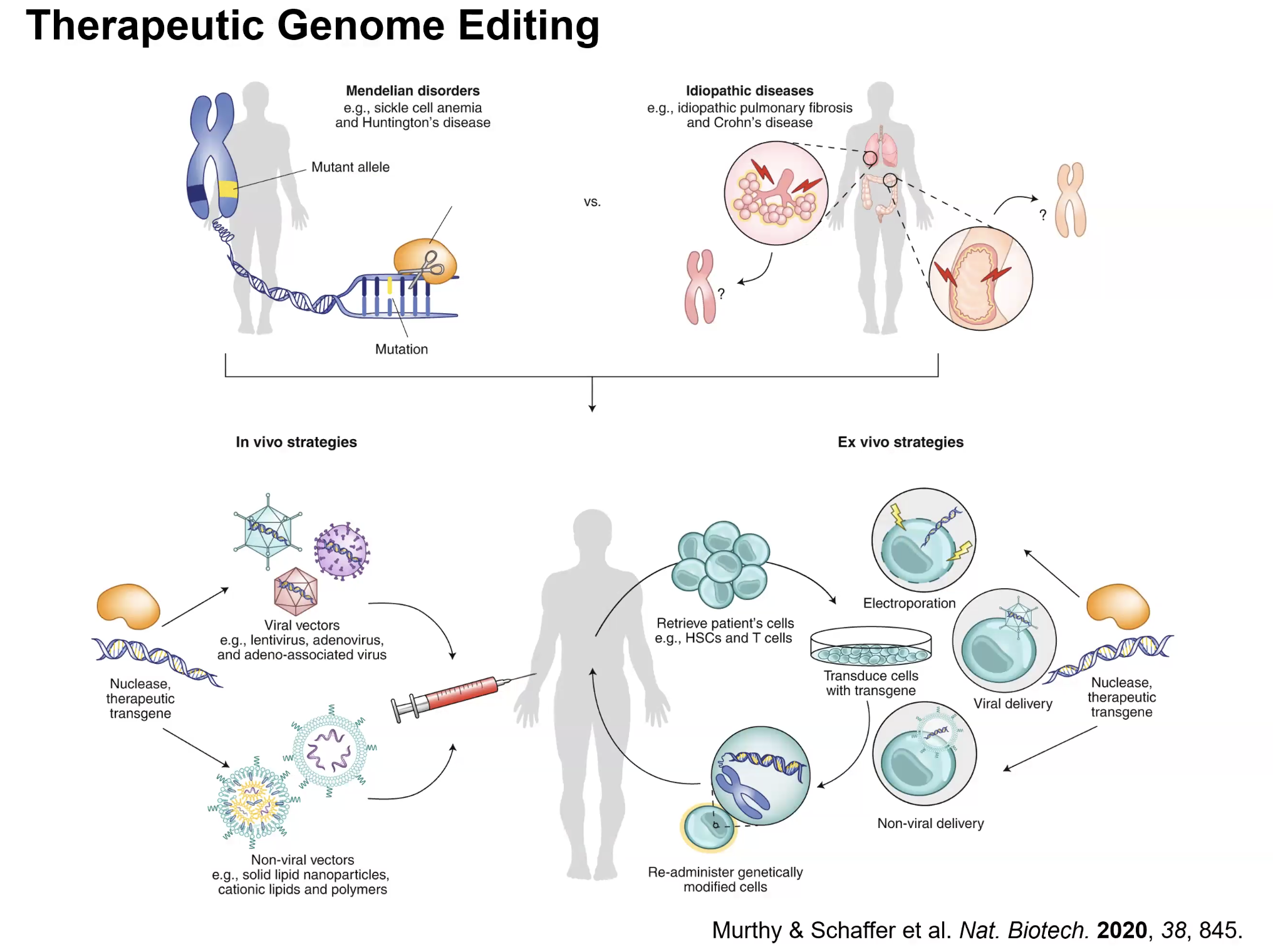
RNP delivery advantages for in vivo editing
- Minimized off-target editing (due to limited lifetime of RNPs)
- Reduced immunogenic effects by viral vectors or mRNA
- Viral vectors can elicit immune responses, like neutralizing antibodies and T-cell responses
- mRNA activates innate immune sensors, like TLR7/8
- RNPs are protein-based so don’t have nucleic acid patterns recognized by immune sensors (evolved to detect viral/bacterial genetic material)
- Swift editing w/o transcription or translation processes (RNPs are pre-assembled and ready to function, faster editing kinetics)
- No genome integration issues by viral vectors
GeoCas9: a compact, thermostable protein
- Most commonly used form of Cas9: SpyCas9
- GeoCas9 (Harrington, LB et al., Nat Comm 2017)
- Pro: thermal (high temp) resistant, smaller, more stable (at higher temp)
- DLS shows GeoCas9 with fewer aggregates vs. SpyCas9 at physiological temp (37C)
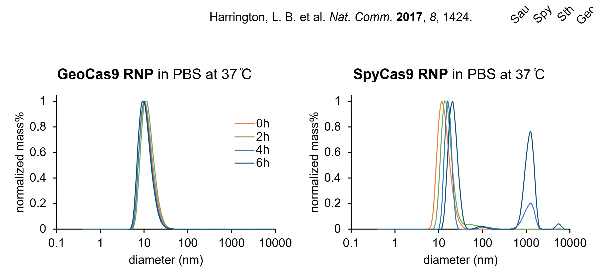
- DLS shows GeoCas9 with fewer aggregates vs. SpyCas9 at physiological temp (37C)
- Con: but GeoCas9 very crappy at editing compared to SpyCas9
- SpyCas9 edits NPCs at >70%, measured using TdTomato Ai9 mice, whereas GeoCas9 edits NPCs at <0.1%)
- Pro: thermal (high temp) resistant, smaller, more stable (at higher temp)
Key Question 1
Can we engineer GeoCas9 to be an efficient and stable gene editor by improving its editing activity while maintaining its thermal stability?
Directed Evolution improves GeoCas9’s editing efficiency while preserving thermostability
Used a dual-plasmid selection system
- System consists of two plasmids:
- First plasmid encodes: Cas9 protein and gRNA (aka the proD-tetA/tetR-GeoCas9-CAM^r system)
- sgRNA targets ccdB gene using a GAAA PAM sequence (aka the AMP^R-pBAD-ccdB toxin system)
- Second plasmid encodes: ccdB toxin downstream of an inducible promoter
- First plasmid encodes: Cas9 protein and gRNA (aka the proD-tetA/tetR-GeoCas9-CAM^r system)
- The selection process
- ccdB gene produces lethal toxin when expressed
- If GeoCas9 efficiently cuts ccdB gene, cell survives
- Else if GeoCas9 inefficient at cutting, toxin is produced and kills cell
- selection medium (agar plate) contains chloramphenicol (antibiotic, such that only cells w/ GeoCas9 plasmid-CAM^r system can survive) + arabinose (sugar that induces promoter upstream of ccdB that controls ccdB expression)
- ccdB gene produces lethal toxin when expressed
- Selection outcome
- Efficient target cleavage: cells survive bc ccdB is disrupted
- Inefficient or no target cleavage: cells die due to ccdB toxin expression
- Final mutant: termed GeoCas9 (R1W1), aka iGeoCas9, contains 8 mutations in total
Thermal stability preservation? Yep
iGeoCas9 (GeoR1W1 in graph) has a slightly lower melting temperature (-15C) vs. WT GeoCas9
Gene editing efficiency improvement? Also yes
Tested on Ai9 tdTomato neural progenitor cells (NPCs). Substantially improved editing efficiency: >1000x improvement in gene editing activity from WT GeoCas9
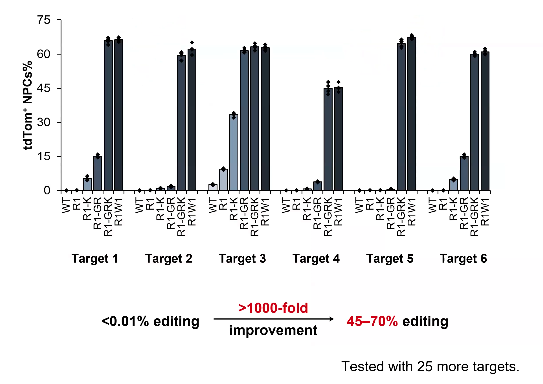
- iGeoCas9 has comparable editing activity to SpyCas9, across 10 different tested targets
iGeoCas9 has minimal off target effects

Recap so far
We have now established an efficient (at editing), stable (at 37C) editor—iGeoCas9—via directed evolution.
RNP delivery offers advantages but is challenging
In vitro RNP delivery methods
- Electroporation (nucleofection)
- Self-deliverable RNP (CPP-conjugated)
- Viral-Like Nanoparticles (VLPs)
- Synthetic LNPs - gold standard for nucleic acid delivery
These methods don’t work great in vivo
- Delivery methods have biocompatibility issues: ability of material or substance to interact with biological systems w/o causing harmful effects (immune responses, inflammation, cell death, tissue damage)
- LNPs - can trigger inflammatory responses
- Electroporation - can cause cell stress and death
- Viral vectors - immunogenic
- High cytotoxicity
- Limited delivery efficiency by different vector systems
- Poor tissue/cell-specificity with most delivery strategies
- Poor RNP-stability in vascular system based on IV injection
Synthetic LNPs seem most promising bc they have been validated in vivo before (e.g. Pfizer/Moderna COVID vaccine), but they’ve typically been developed for mRNA delivery, not protein (RNP) delivery.
Key Question 2
Can LNPs be used to deliver iGeoCas9 RNP (in vivo, eventually)?
Testing LNP delivery of RNPs in vitro
Experimental setup
- Treatment: tested 3 different editors in RNP form (SpyCas9, iCas12a, iGeoCas9) using Ai9 tdTomato NPCs
- Control: RNP delivery via electroporation (nucleofection)
- Response variable (measuring): tdTom+ NPCs %, aka editing rate
Outcomes: all 3 RNPs delivered via nucleofection edited NPCs at a decent rate (60% or more). However, when delivered via LNPs, editing rate decreases for all 3 RNPs.
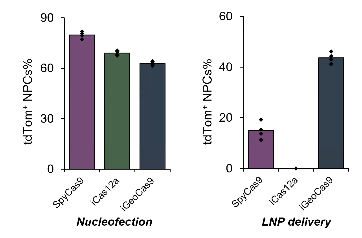 Why is it that iCas12a RNP could not be delivered via LNP at all, whereas iGeoCas9 still has 40% editing efficiency?
Why is it that iCas12a RNP could not be delivered via LNP at all, whereas iGeoCas9 still has 40% editing efficiency?
How LNPs are made
Charge interactions between lipids (positively-charged) and cargo (nucleic acids are negatively charged) allows LNPs to self-assemble with cargo (nucleic acid) inside
What makes an RNP a good candidate for LNP delivery?
Why is iGeoCas9 RNP a good candidate for LNP delivery?
- RNP stability (against lipid molecules and organic solvents like DMSO)
- iGeoCas9 is high stability
- Physical features (charges) required for LNP packaging
- iGeoCas9 has relatively large negative net charge for RNP complex (-74)
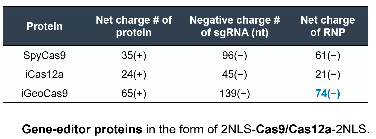
- iGeoCas9 has relatively large negative net charge for RNP complex (-74)
Optimized Formulations Encapsulate iGeoCas9 RNP
Optimized for lipid compositions of LNPs. Settled on 2 formulations using 4 commercial lipids and 2 synthetic lipids w/ an ester linker in the middle

- Standard formula (abbrev as “std formula”)
- Cationic formula (abbrev as “cat formula”)
These two formulations give good size and uniformity (measured using DLS) of RNP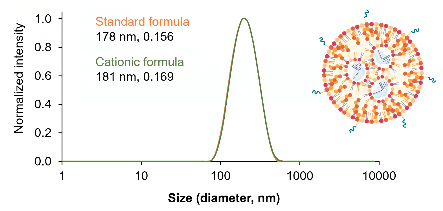
Acetal functionality in lipids promotes endosomal escape
Lipids are pH-sensitive and biodegradable upon treatment w/ reducing agent (like DTT): lipid with labile ester linkers break down at endosomal pH 5-6, promoting endosomal escape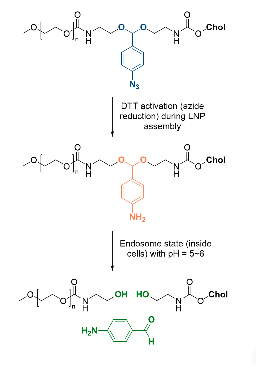
LNP stability?
Endosomal escape is great, but what about stability of LNP using labile lipids?
LNP complex is highly stable: LNPs (both standard and cationic formulations: can be stored at 4C in neutral buffer (PBS/water) for over a month without any obvious decrease in editing activity.
LNP delivery shows comparable editing efficiency to electroporation

Research Question 3
Can LNPs co-deliver RNPs and ssDNA templates (for HDR purposes, to incorporate desired changes to target genomic loci)?
Yes, LNPs can co-package iGeoCas9 RNP and ssDNA templates
observation using DLS: slight positive size shift in LNPs w/ ssDNA and RNP vs. those w/ only RNP
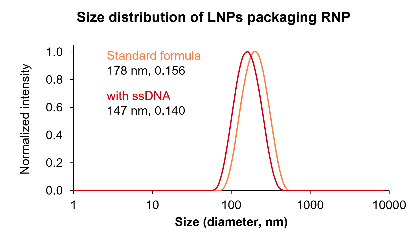
LNP co-delivery triggers effective HDR at endogenous sites
- Tested standard and cationic LNP formulations for HDR editing at the EMX1 gene and AAVS1 locus on HEK293T cells
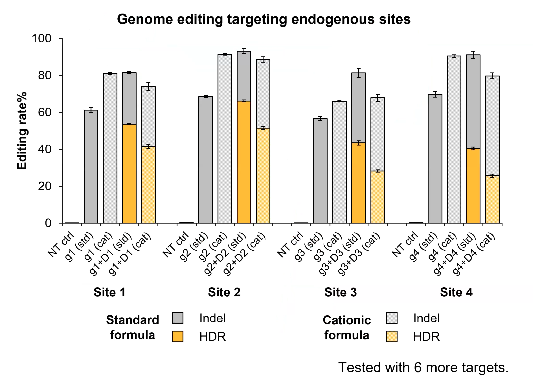
Key research question 4
What about in vivo LNP delivery of iGeoCas9 RNPs?
Additional considerations for in vivo delivery (via IV injection)
- Delivery efficiency
- Tissue specificity
- Cytotoxicity/immunogenicity
Further LNP optimization for in vivo delivery ⇒ higher editing efficiency & lower cytotoxicity
Reoptimized LNPs w/ biodegradable lipids
- Std formula ⇒ optimized: Formula FX ✅ (specific to liver)
- Cat formula ⇒ Formula FC8 🫁 (specific to lung)
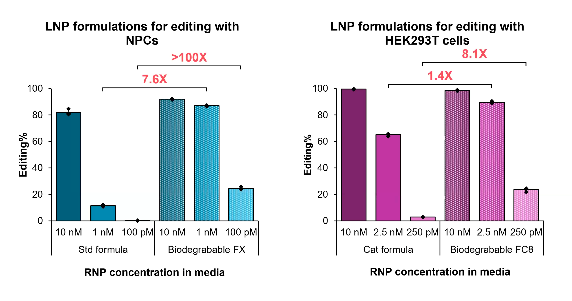
Delivering iGeoCas9 RNP via LNPs in tdTomato mice: edits liver w/ high efficiency, edits lung w/ good efficiency
Experiment:
- Used Ai9 tdTomato mouse
- Day 1: (IV) Retro-orbital injection of LNP = IV injection
- Day 10: Flow analysis and imaging
- Data collection: diff organs collected for editing analysis
Results:
- Formula FX gave robust liver editing results
- But when using FC8 formula, delivery specificity shifted from liver to the lung, good editing levels in the lung
Future work
Developing LNP formulations that can effectively target tissues beyond liver and lung for in vivo editing.
Achieving cell-type specificity.
My comments
This just seems like black magic: how does changing the lipid composition completely change the target organ? that’s wild
My summary
- Intro: RNP delivery of gene editors is advantageous for in vivo editing (minimized off-target editing, reduced immunogenic effects, swift editing since RNP is pre-assembled)
- The authors’ work
- GeoCas9 is a thermostable, compact Cas9 variant with little editing activity. The authors engineered GeoCas9 using directed evolution to improve GeoCas9’s editing efficiency while preserving its thermostability.
- The authors identified LNPs as a good strategy to deliver iGeoCas9 RNPs in vivo since LNPs have been validated in vivo in humans before for mRNA delivery.
- They found that LNPs can co-deliver iGeoCas9 RNPs and ssDNA templates (for HDR) in vitro
- In vivo testing via IV (retroorbital) injection in tdTomato mice showed
- high editing efficiency in liver (with standard LNP formula “FX”)
- and less high (but still good) editing efficiency in lung (with cationic LNP formula “FC8”)
Link to recording: https://gess.hms.harvard.edu/event/tbd-and-tbd-1
- Accompanying paper: https://doi.org/10.1038/s41587-024-02437-3